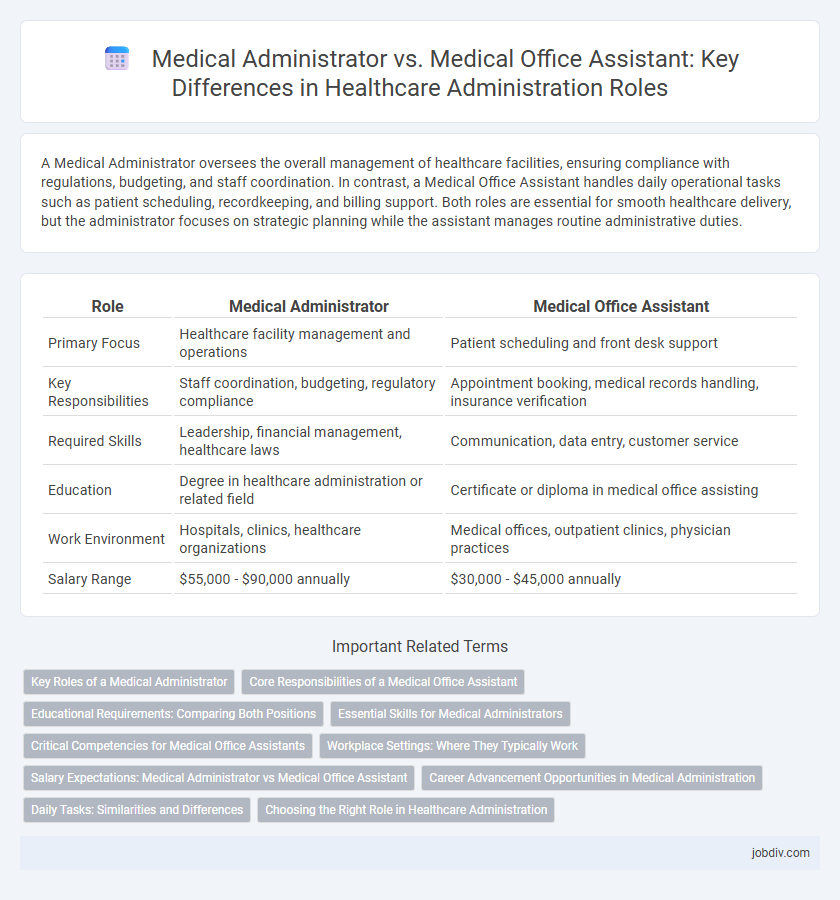A Medical Administrator oversees the overall management of healthcare facilities, ensuring compliance with regulations, budgeting, and staff coordination. In contrast, a Medical Office Assistant handles daily operational tasks such as patient scheduling, recordkeeping, and billing support. Both roles are essential for smooth healthcare delivery, but the administrator focuses on strategic planning while the assistant manages routine administrative duties.
Table of Comparison
| Role | Medical Administrator | Medical Office Assistant |
|---|---|---|
| Primary Focus | Healthcare facility management and operations | Patient scheduling and front desk support |
| Key Responsibilities | Staff coordination, budgeting, regulatory compliance | Appointment booking, medical records handling, insurance verification |
| Required Skills | Leadership, financial management, healthcare laws | Communication, data entry, customer service |
| Education | Degree in healthcare administration or related field | Certificate or diploma in medical office assisting |
| Work Environment | Hospitals, clinics, healthcare organizations | Medical offices, outpatient clinics, physician practices |
| Salary Range | $55,000 - $90,000 annually | $30,000 - $45,000 annually |
Key Roles of a Medical Administrator
A Medical Administrator oversees the coordination of healthcare facilities, ensuring compliance with regulations, managing budgets, and optimizing patient care delivery systems. They handle strategic planning, human resource management, and the implementation of health information technology to improve operational efficiency. Their role is critical for maintaining organizational standards, quality control, and fostering communication between medical staff and administrative teams.
Core Responsibilities of a Medical Office Assistant
Medical Office Assistants handle core responsibilities such as managing patient scheduling, maintaining accurate medical records, and facilitating communication between healthcare providers and patients. They perform administrative tasks including billing, coding insurance claims, and managing patient correspondence to ensure smooth office operations. Their role is crucial in supporting the daily functions of medical facilities by combining clerical duties with direct patient interaction.
Educational Requirements: Comparing Both Positions
Medical administrators typically require a bachelor's degree in healthcare administration, public health, or business, which provides comprehensive knowledge of healthcare systems, financial management, and policy. Medical office assistants often need a postsecondary certificate or diploma in medical office administration, emphasizing practical skills like medical billing, coding, and patient communication. The educational requirements for medical administrators are generally more extensive, reflecting their broader managerial responsibilities and decision-making roles.
Essential Skills for Medical Administrators
Medical administrators require advanced organizational skills, proficiency in healthcare management software, and a deep understanding of medical billing and compliance regulations. Effective communication and leadership abilities are essential for coordinating between medical staff, patients, and insurance providers. Expertise in data analysis and strategic planning enhances operational efficiency and patient care quality in healthcare facilities.
Critical Competencies for Medical Office Assistants
Medical Office Assistants must excel in patient communication, appointment scheduling, and medical record management to support clinical operations efficiently. Proficiency in electronic health records (EHR) software and understanding basic medical terminology are critical for accuracy and compliance. Strong organizational skills and multitasking abilities enable Medical Office Assistants to handle front desk responsibilities while facilitating seamless interaction between patients and medical administrators.
Workplace Settings: Where They Typically Work
Medical administrators typically work in hospitals, healthcare organizations, and large medical facilities where they manage operations and oversee administrative functions. Medical office assistants are commonly found in smaller settings such as private clinics, physician offices, and outpatient centers, where they handle patient scheduling and clerical duties. Both roles are essential in ensuring efficient healthcare delivery but differ significantly in the complexity and scope of their workplace environments.
Salary Expectations: Medical Administrator vs Medical Office Assistant
Medical Administrators typically earn between $60,000 and $90,000 annually due to their leadership roles and responsibility for managing healthcare operations. Medical Office Assistants usually have lower salary expectations, ranging from $30,000 to $45,000, reflecting their focus on clerical and administrative support tasks. Salary differences arise from varying levels of education, experience, and scope of duties within healthcare administration.
Career Advancement Opportunities in Medical Administration
Medical administrators often have greater career advancement opportunities due to their leadership roles in healthcare facilities, overseeing budgets, compliance, and staff management. In contrast, medical office assistants typically support daily operations with limited scope for upward mobility focused on administrative tasks. Pursuing certifications or degrees in health administration can accelerate advancement for both roles, with medical administrators more likely to reach senior management positions.
Daily Tasks: Similarities and Differences
Medical Administrators oversee healthcare facility operations, managing staff schedules, budgets, and regulatory compliance, while Medical Office Assistants handle patient interactions, including appointment scheduling, medical record management, and billing processes. Both roles require proficiency in electronic health records (EHR) systems and strong organizational skills to ensure smooth office functionality. The primary difference lies in scope, with Medical Administrators focusing on strategic management and Medical Office Assistants concentrating on direct patient support and clerical tasks.
Choosing the Right Role in Healthcare Administration
Choosing the right role in healthcare administration depends on career goals, responsibilities, and required skills. Medical administrators oversee operations, manage staff, and ensure regulatory compliance, making it ideal for those seeking leadership and strategic planning roles. Medical office assistants handle clerical tasks such as scheduling, patient communication, and record-keeping, suited for individuals preferring direct patient interaction and administrative support.
Medical Administrator vs Medical Office Assistant Infographic

 jobdiv.com
jobdiv.com